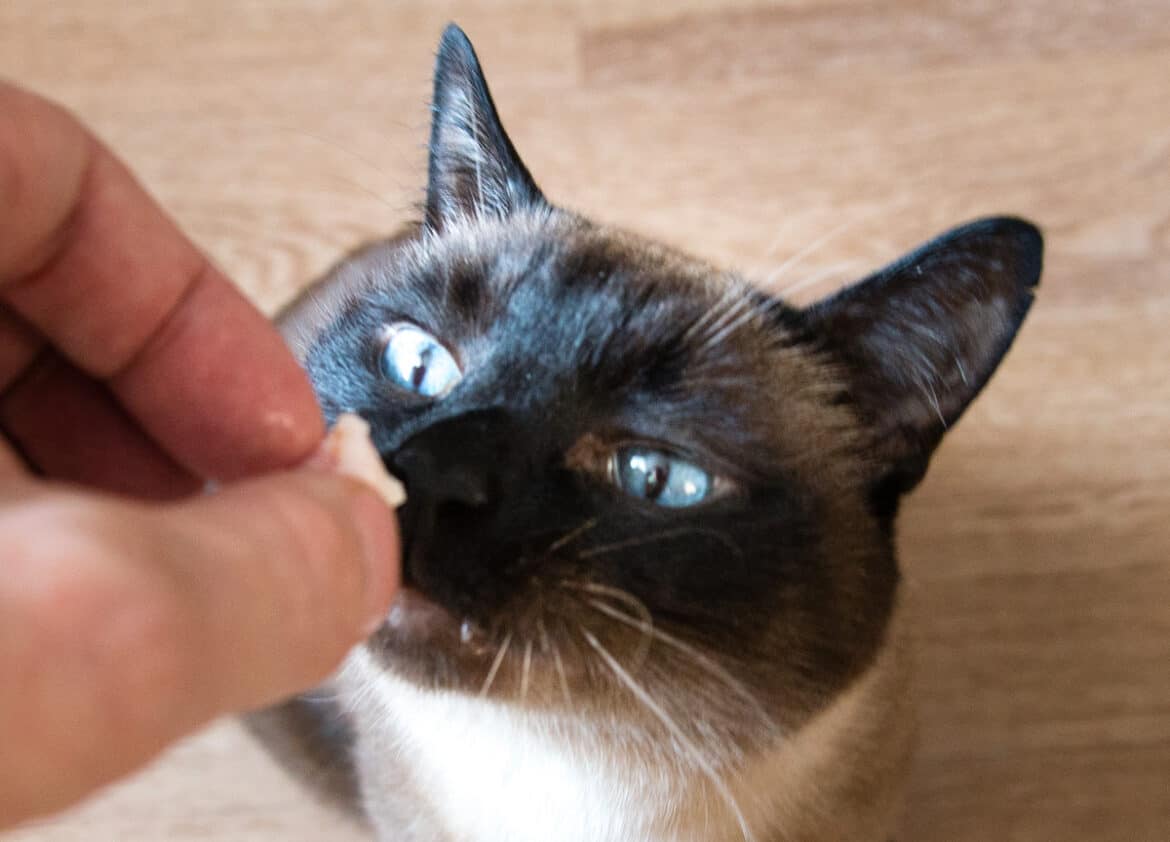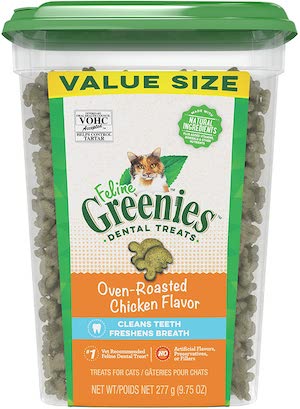Many of us love to feed our cat a tasty treat now and then, and you can be sure that kitty loves a delicious snack just as much. There are many types of commercial treats on the market for cats that are completely safe for our feline friends if fed in moderation.
Many owners like to feed their cats homemade delights too, like fresh meat and fish. One of the questions we were asked recently was whether it was safe to feed cats saltine crackers. Here will discuss in more detail the safety factors of feeding your cat this product and an in-depth look at the ingredients used in this foodstuff.
So, can cats eat saltine crackers? No, cats cannot eat saltine crackers. These crackers are high in salt and fat, which in excess can cause dehydration and obesity in cats, respectively. Healthy amounts of fat and salt are already included in your cat’s normal food, and saltine crackers do not add any nutritional benefit to your cat’s diet.
Stick with us as we dive into the reasons you really shouldn’t feed saltines to your fluffy friend, no matter how cute they are when they beg.
Can Cats Eat Saltines in Small Quantities?
The strange thing is that some cats actually like saltine crackers because of the taste of salt and fat, the exact two ingredients that make them so bad for cats. This is certainly understandable from a human perspective. Are donuts good? Yes! Are they good for you? Nope.
However, this doesn’t mean it’s okay to let your cat have a saltine. Instead, feed them healthier treats meant for cats to give them a little something special and a break from their everyday diet.
While feeding your cat the odd saltine cracker now and then will not cause them any harm for the most part, it is highly recommended that you do not feed them saltines regularly. By doing so, is likely to make your cat ill and can cause health issues in the long term.
Saltine crackers do not have the right nutrition for a feline diet, which is why it is recommended to only feed treats that are low in fat and high in protein to fit in well with their regular daily meals.
One saltine cracker won’t hurt as the odd treat, but regular feeding of this food type is discouraged for the health and wellbeing of your kitty. There are so many better treats out there! Why not feed them something they’ll love that will love them right back?
Suggested: Feline Greenies Natural Dental Care Cat Treats
These treats from Greenies are made with all-natural ingredients and zero artificial flavors or preservatives.
They’re well-balanced for a healthy addition to your cat’s diet. These treats are even perfect for cats that need to lose weight, as they’re only less than 2 calories each.
Beyond that, these treats have the added benefit of helping keep your cat’s teeth fresh, clean, and healthy! They’re among the top recommended treats for cats by U.S. veterinarians. Give your cat two of these daily, and they’ll have fresher breath and a tartar-free smile.
They come in multiple flavors, including roast chicken, tuna, catnip, and salmon. All flavors are highly-rated across the board.
Why Are Saltine Crackers Bad for Cats?
Saltine crackers are considered to be bad for cats if fed regularly or in large quantities. Many owners see these tasty snacks as being similar to feeding commercial cat treats that are of the biscuit variety.
Unfortunately, this is not the case, and although regular cat treats are not 100% healthy, they are formulated in such a way to provide the right types of nutrition for the beloved felines in our lives.
Saltine crackers have been specifically made for human consumption. Although they are not considered to be the most nutritious foodstuff, the human body can deal with these contents much better than that of our feline companions. Two main issues should be considered when feeding saltine crackers to cats.
1. High Levels of Salt
Foods that contain high levels of salt are notoriously bad news for cats. Saltine crackers contain very high levels of salt. Too much salt can often make cats very dehydrated. It can be difficult to get cats to drink enough water at the best of times.
You may be thinking that providing your cat with more salt will encourage them to drink more. However, the increased water intake will still not be enough to counteract dehydration levels. Dehydration can cause severe health issues for our feline friends who are already prone to liver and kidney problems.
Another important thing to note about high salt intake is the risks this incurs for male cats in particular. High levels of salt in the male cat’s system is known to form crystals in the bladder.
This can result in blockages of the bladder, which essentially stops them from urinating. Urinary blockages can be extremely painful and a life-threatening condition if not dealt with quickly enough.
Salt poisoning is also a possibility. It would require an elevated level of salt in the system to get to these levels, however, it just isn’t worth taking that risk. Salt poisoning can be life-threatening with the interim signs being vomiting, diarrhea, decreased appetite, lethargy, and in severe cases tremors, seizure, and coma.
2. High Levels of Fat
The fat content in all of your cat’s food is something you should consider. Saltine crackers vary greatly in fat content, but you should be conscious of the fact that too much fat is not healthy for your kitty.
Many cats are prone to becoming overweight or obese. It can be very difficult to manage obesity in cats and once they get to that stage, it can be difficult to get them to lose weight. The best way is to not let your cat become overweight in the first place.
Managing your cat’s dietary intake is vital and checking ingredient labels for fat content is a great way to avoid unhealthy foods for your kitty to consume. Saltine crackers have quite a high fat content, especially if consumed in large quantities.
The odd saltine cracker here and there will not make much difference, but if you have a cat that absolutely adores them, it can be hard for us to say no as doting cat parents. The best way to manage this is to not feed saltine crackers to our kitty in the first place.
What Ingredients Do Saltines Contain?
It is important when deciding what to feed your cat as a treat that you read the ingredients list and understand fully what you are feeding to your kitty and in what quantities. Let’s take a look at the standard ingredients list for saltine crackers to give you a much clearer picture of how this product is formulated.
Here are the ingredients in saltines that may be harmful to your cat:
- Wheat Flour – Small amounts of wheat flour are ok for cats to eat. However, note that many cats cannot stomach the gluten in wheat, which can cause stomach pain and allergic reactions. Unfortunately, wheat flour is the first ingredient in saltine crackers, which gives you a clear indication of how unsuitable this treat can be for cats.
- Niacin – Niacin is a water-soluble vitamin that is vital for energy metabolism. It is said that cats require 2.4 times more niacin in their diet than a dog would. With that being said, research has shown that more than 350mg per kg of body weight is toxic for cats. Cats would need to consume an excessive amount of saltine crackers for niacin to become toxic in the bloodstream.
- Reduced Iron – Iron is an essential part of a cat’s diet. Most of the cat’s iron consumption is taken from their daily diet of meat and fish. This will usually provide them with the right amount of iron their body needs to stay fit and healthy. Saltine crackers contain reasonably low levels of iron in comparison and therefore this product does not have any real benefit.
- Canola and Palm Oil – Both canola and palm oil are very fattening for cats and saltine crackers contain quite large doses of these oils. There is very little research into how safe canola oil is for cats, however, no serious side effects have ever been discovered. Palm oil is considered reasonably safe. But the properties of these two ingredients are far too fattening for cats and one of the main reasons saltine crackers are not a good idea for our kitties to consume.
- Baking Soda and Sea Salt – Saltine crackers have an extremely high baking soda and sea salt content. Foods with high levels of salt can cause some serious complications for cats, such as dehydration and the possibility of blockages, particularly in male cats. This is one of the reasons we strongly advise against feeding too much of this food type to your kitty. These ingredients do not have any real benefit as far as cats are concerned.
- Melted Barley Flour – Flour in general is not a great addition to a cat’s diet. It can cause an upset stomach thanks to the cat’s delicate system and allergies are not uncommon. Barley in particular is not dangerous for a cat to consume, but can often cause vomiting. Although saltine crackers do not contain high levels of malted barley flour, this is still an ingredient that is best avoided since the side effects that can be experienced are not very pleasant.
- Yeast – Yeast can be dangerous for cats if fed in high doses. Just like dough, it can expand in your cat’s system. It also has the ability to produce enough carbon dioxide and alcohol to cause some serious problems for cats. A few saltine crackers here and there are not likely to cause many issues, but in larger doses, there is a real danger present.
Overall, saltine crackers are not a good solution for cats as a treat. The high fat and salt content make this a highly unhealthy treat that is likely to cause your cat complications if fed too often or in large quantities. The addition of flour and yeast can also be a red flag in the formula.
There are many commercial cat treats on the market that are much safer and healthier options and will provide your cat with far more nutrition than a saltine cracker. We, therefore, advise against feeding saltine crackers to your cat to ensure they stay happy and healthy for years to come.
Up Next: Can Cats Drink Oat Milk?

